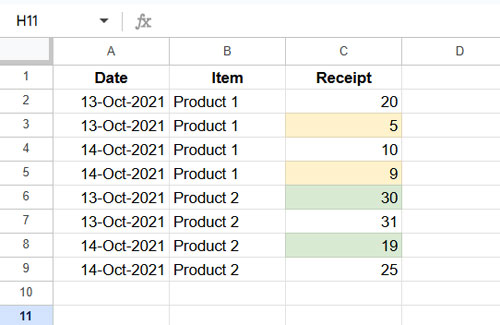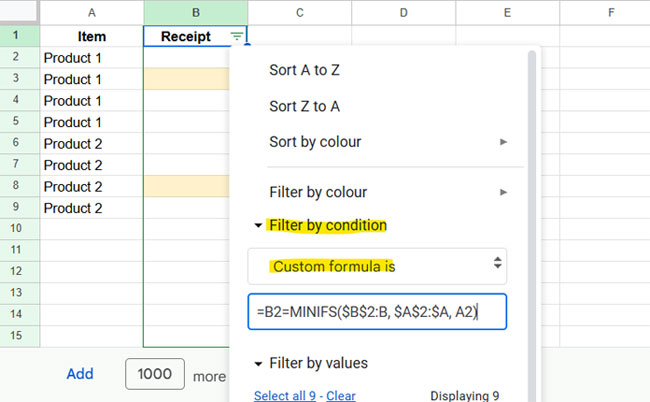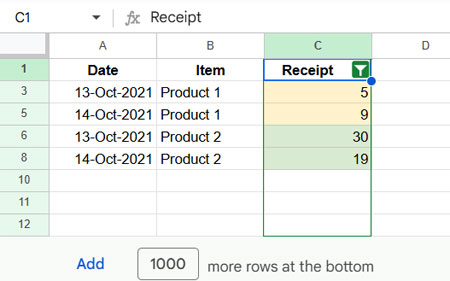This tutorial explains how to find and filter the minimum or maximum value in each group in Google Sheets using a formula or the Filter command.
Use the formula when you want to extract the smallest or largest values for each group into a new range. Use the Filter command when you want to display only the relevant values within the source data.
Find the MIN Values in Groups (Formula Approach)
You might want to find the minimum value in groups with or without a date column. The formula varies depending on the scenario.
Example 1: Finding the Lowest Value in Each Group
Consider the following sample data (A1:B):

To get the minimum value in each group, use the following QUERY formula:
=QUERY(A1:B, "select Col1, min(Col2) where Col1 is not null group by Col1")This will return the minimum receipt quantity for each product:
| Item | min Receipt |
| Product 1 | 5 |
| Product 2 | 19 |
How the Formula Works:
A1:B-> The data range.Col1-> The grouping column (adjust it if your grouping column is different, e.g.,Col4for column 4).Col2-> The column from which to extract the lowest value.
Notes:
- Column numbers are relative to the range, not the sheet.
- To modify the labels in the result, use the LABEL clause in QUERY.
Example 2: Finding the Lowest Value in Each Group by Date
In certain cases, you may want to find the minimum value in each group based on date, such as tracking the lowest sales per product per day.
Here’s a sample dataset (A1:C):

To find the lowest value per group and date, use:
=QUERY(A1:C, "select Col2, Col1, min(Col3) where Col1 is not null group by Col2, Col1")Result:
| Item | Date | min Receipt |
| Product 1 | 13-Oct-2021 | 5 |
| Product 1 | 14-Oct-2021 | 9 |
| Product 2 | 13-Oct-2021 | 30 |
| Product 2 | 14-Oct-2021 | 19 |
How the Formula Works:
A1:C-> The data range.Col2-> The first column to group by (Item/Category).Col1-> The date column.
Find the MAX Values in Groups (Formula Approach)
To find the maximum values in each group, replace the min function with max in the formulas.
Example 1: Finding the Largest Value in Each Group
=QUERY(A1:B, "select Col1, max(Col2) where Col1 is not null group by Col1")| Item | max Receipt |
| Product 1 | 20 |
| Product 2 | 31 |
Example 2: Finding the Largest Value in Each Group by Date
=QUERY(A1:C, "select Col2, Col1, max(Col3) where Col1 is not null group by Col2, Col1")| Item | Date | max Receipt |
| Product 1 | 13-Oct-2021 | 20 |
| Product 1 | 14-Oct-2021 | 10 |
| Product 2 | 13-Oct-2021 | 31 |
| Product 2 | 14-Oct-2021 | 25 |
Find the MIN or MAX Values Using the Filter Command
Filtering the source data directly has two advantages:
- You can see and edit the results in the original range.
- You avoid creating additional ranges, keeping your sheet clean.
To filter the min or max values by group, apply the filter function to the numeric column.
Example 1: Filtering the Smallest Value in Each Group
We will use the same two-column dataset, where Item is in column A and Receipt in column B.
Steps:
- Select B1:B.
- Click Data > Create a Filter.
- Click the filter drop-down in B1.
- Select Filter by condition > Custom formula is.
- Enter the formula:
=B2=MINIFS($B$2:B, $A$2:$A, A2)
- Click OK.
This filters the smallest values in each group.
How the Formula Works:
MINIFS($B$2:B, $A$2:$A, A2)- MINIFS finds the smallest value in B2:B, where A2:A matches the item in A2.
- This applies to each row as A2 updates to A3, A4, and so on within the filter range.
=B2 checks whether each row’s value matches the minimum value in its group. If it does, the row is included in the filter.
Example 2: Filtering the Largest Value in Each Group
To filter the maximum value instead, use:
=B2=MAXIFS($B$2:B, $A$2:$A, A2)Example 3: Filtering the Smallest Value in Each Group by Date
If dates are in column A, items in column B, and receipt quantities in column C, use:
- Select C1:C.
- Click Data > Create Filter.
- Click the filter drop-down in C1.
- Select Filter by condition > Custom formula is.
- Enter:
=C2=MINIFS($C$2:C, $A$2:$A, A2, $B$2:$B, B2) - Click OK.
This filters the smallest values in each group by date and category.

How the Formula Works:
MINIFS($C$2:C, $A$2:$A, A2, $B$2:$B, B2)finds the minimum value in C2:C where A2:A = A2 and B2:B = B2.- If
C2matches this minimum, the row is shown in the filter.
This applies to each row in the range.
Example 4: Filtering the Largest Value in Each Group by Date
Simply replace MINIFS with MAXIFS:
=C2=MAXIFS($C$2:C, $A$2:$A, A2, $B$2:$B, B2)FAQs
Does the formula update when new data is added?
Yes, since we use open-ended ranges, the formula captures new values dynamically.
Does the filter menu refresh automatically when new values are added?
No, you must click the filter drop-down and select OK to refresh the filtered data.





















